Why Every Business Needs a Customer Service Metrics Dashboard in 2025

In 2025, using a customer service metrics dashboard will no longer be optional—it will be essential for businesses to thrive. This powerful tool provides real-time insights that help you improve customer satisfaction, optimize operations, and elevate business performance. Without it, you risk falling behind in delivering exceptional support and missing critical opportunities to enhance service quality.
Imagine having a clear view of your customers' needs, team productivity, and service data in one place. Tools like Sobot's cutting-edge solutions make this possible by integrating advanced technology into your dashboard. These insights empower you to act faster, solve problems efficiently, and build stronger connections with your customer base. The result? A competitive edge that keeps your business ahead in today's fast-paced environment.
Don’t let inefficiencies hold you back—embrace the future of customer support with a reliable dashboard.
The Role of Customer Service Metrics Dashboards in Business Success
Defining a customer service metrics dashboard
A customer service metrics dashboard is your command center for tracking and analyzing critical business insights. It consolidates essential data into a live dashboard, offering a clear view of customer interactions, team performance, and operational efficiency. Think of it as a digital tool that transforms raw data into actionable insights, enabling you to make data-driven decisions with confidence.
Key components of a dashboard include metrics like Customer Satisfaction (CSAT), Net Promoter Score (NPS), and First Response Time (FRT). These metrics help you measure service quality, customer loyalty, and team productivity. For example, tracking ticket volume trends can reveal workload patterns, allowing you to allocate resources effectively. By combining operational data (O-data) with experience data (X-data), dashboards provide a complete picture of customer perceptions and business performance.
Why metrics are critical for customer support teams
Metrics are the backbone of customer support excellence. They help you understand what’s working and what needs improvement. For instance, Average Handle Time (AHT) highlights areas where efficiency can be improved, while Customer Satisfaction metrics like CSAT and CES pinpoint service quality gaps.
Dashboards also empower your team to prioritize tasks. Effective dashboards rank metrics by urgency, ensuring that critical actions—like resolving high-priority tickets—are addressed first. This focus on key performance indicators (KPIs) boosts productivity and prevents your support department from becoming a cost center.
Moreover, metrics tied to customer experiences, such as response times and resolution rates, directly impact satisfaction and loyalty. Publicizing these metrics within your team motivates them to perform better, fostering a culture of continuous improvement.
Real-time insights for proactive decision-making
Real-time data dashboards are game-changers for customer support. They provide immediate visibility into key metrics, allowing you to identify trends and issues as they arise. For example, monitoring Average Resolution Time in real-time helps you spot delays and take corrective action before they affect customer satisfaction.
These live dashboards enable timely decisions that keep your operations agile. Imagine adapting to market changes or customer demands instantly, thanks to up-to-date insights. Real-time monitoring also enhances performance tracking, helping you fine-tune your strategies for better outcomes.

Sobot’s Voice/Call Center integrates seamlessly with dashboards, offering features like call tracking and AI-powered Voicebots. These tools provide real-time data that supports proactive problem-solving and personalized customer interactions. By leveraging such advanced solutions, you can stay ahead of challenges and deliver exceptional support experiences.
Benefits of Using a Customer Service Metrics Dashboard
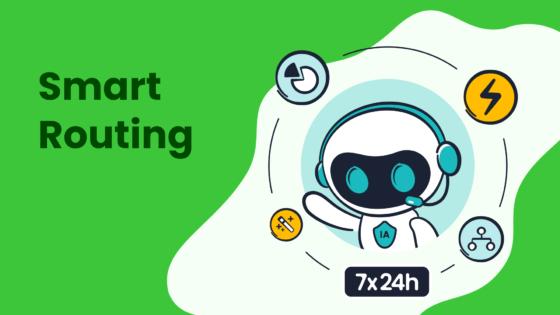
Enhanced customer satisfaction and loyalty
A customer service metrics dashboard empowers you to deliver exceptional service by providing actionable reports and real-time insights. When you understand your customers' needs and preferences, you can tailor your support to exceed their expectations. For example, businesses that monitor customer satisfaction metrics like CSAT and NPS can identify areas for improvement and implement changes proactively.
Consider Company B, which used a customer satisfaction dashboard to detect a decline in ratings. By addressing the root causes, they improved satisfaction and loyalty significantly. Similarly, data dashboards help reduce customer drop-offs by 7% and avoid revenue losses of up to $400,000 per month. These measurable gains highlight how dashboards can transform your customer relationships into long-term loyalty.
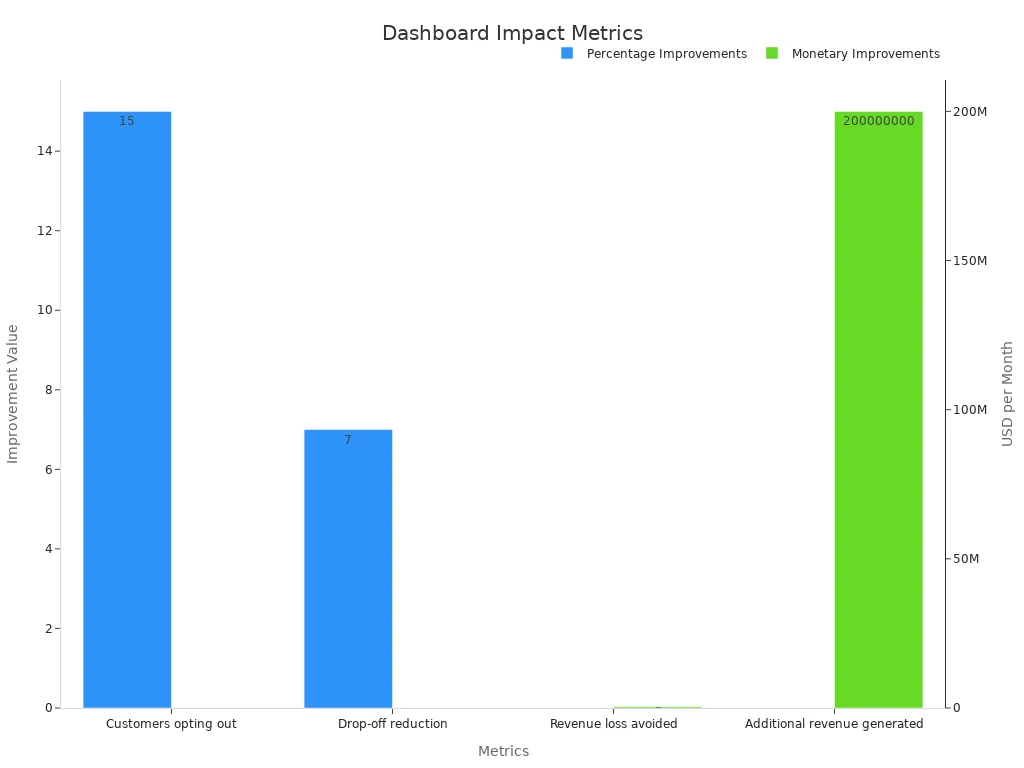
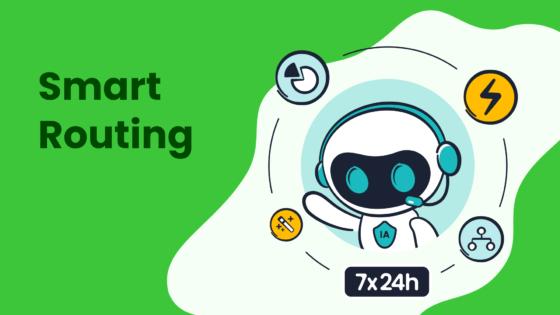
Sobot’s solutions, like the Voice/Call Center, enhance customer satisfaction by integrating features such as smart call routing and AI-powered Voicebots. These tools ensure faster resolutions and personalized interactions, fostering trust and loyalty.
Improved team productivity and accountability
Customer service dashboards streamline your team's workflow, making them more productive and accountable. By tracking metrics like Average Resolution Time and ticket volume trends, you can identify bottlenecks and allocate resources effectively. Teams using dashboards report faster resolution times, which reduce customer wait times and improve overall service efficiency.
For instance, Company I implemented a support performance dashboard to optimize workflows and training. This led to quicker response times and higher satisfaction ratings. Dashboards also provide visibility into individual and team performance, motivating employees to meet their goals.
Sobot’s unified workspace consolidates customer data and communication channels, enabling your team to manage inquiries efficiently. With features like real-time monitoring and bulk outbound tasks, your agents can focus on delivering high-quality support while staying accountable for their performance.
Data-driven strategies for operational efficiency
Data dashboards are essential for driving operational efficiency. They allow you to visualize key metrics, identify trends, and make informed decisions. Research shows that effective visualization speeds up information processing, which is critical in fast-paced environments. For example, Adobe’s transition to a cloud-based model resulted in a 15% increase in user retention and a 60% reduction in support issues.
Dashboards also help you prioritize tasks by displaying a structured hierarchy of information. This clarity ensures that your team focuses on high-impact activities, improving overall efficiency. Atlassian’s agile BI approach, which reduced customer attrition by 23%, demonstrates the power of data-driven strategies.
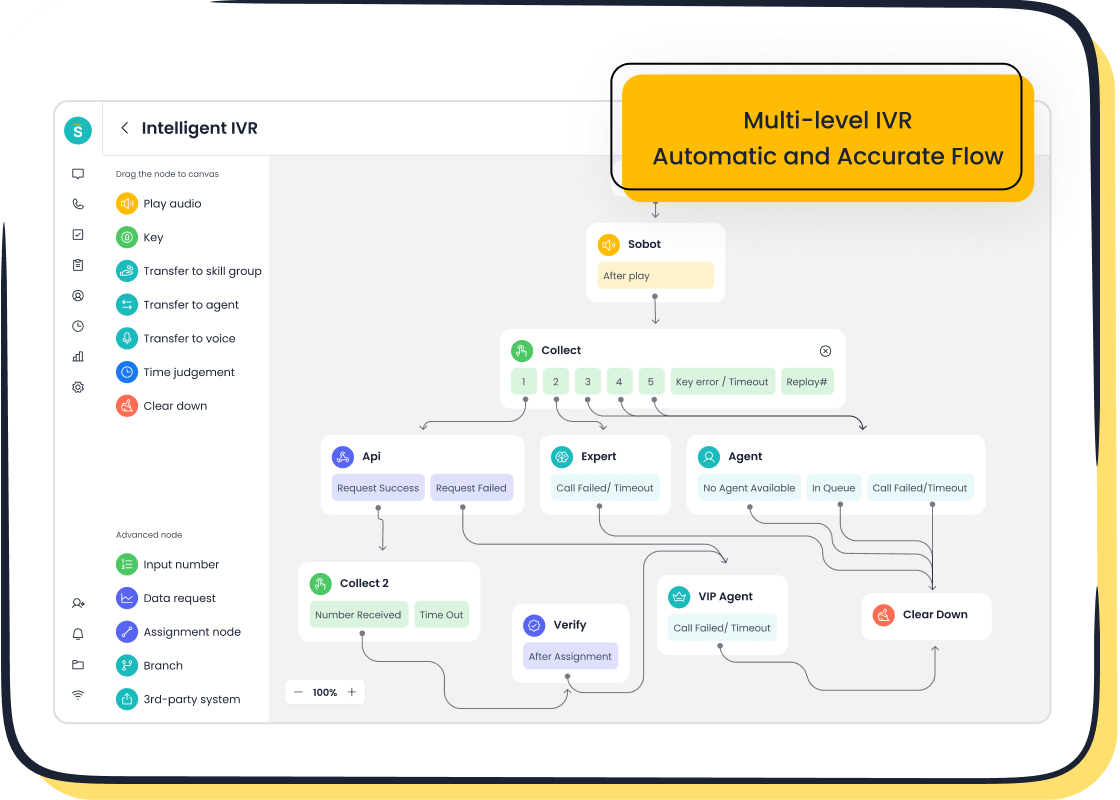
Sobot’s Voice/Call Center supports operational efficiency with features like intelligent IVR and global number availability. These tools simplify workflows and enhance scalability, ensuring your business stays agile and competitive.
How Sobot’s Voice/Call Center supports dashboard integration
Sobot’s Voice/Call Center revolutionizes how businesses integrate customer service metrics dashboards into their operations. By seamlessly connecting call center functionalities with real-time data dashboards, it empowers you to deliver exceptional customer support while optimizing team performance.
Unified Data for Smarter Decisions
Sobot’s Voice/Call Center consolidates all customer interaction data into a single, unified workspace. This integration ensures that every call, inquiry, and resolution is tracked and analyzed in real time. With features like call tracking and intelligent IVR, you gain instant access to actionable insights. These insights allow you to identify trends, address bottlenecks, and make data-driven decisions that enhance service quality.
Real-Time Monitoring and Analysis
The platform’s real-time monitoring capabilities ensure that you stay ahead of potential issues. For example, by tracking metrics like Average Resolution Time and Customer Satisfaction (CSAT), you can proactively resolve problems before they escalate. Sobot’s AI-powered Voicebot further enhances this process by handling repetitive queries, freeing your agents to focus on complex tasks. This combination of automation and real-time data ensures faster resolutions and happier customers.
Proven Success Metrics
Sobot’s Voice/Call Center delivers measurable results when integrated with customer service metrics dashboards. Businesses using this solution have reported significant improvements in key performance indicators. The table below highlights some of these success metrics:
| Metric | Value |
|---|---|
| Reduction in inbound discussion volume | 20% |
| Positive feedback rate | 96%+ |
| Correct answers rate | 80% |
| Customer satisfaction rate (CSAT) | 97% |
| Problem resolution rate | 85% |
| Customer happiness rate | 99% |
| Sign-off rate | 35% increase |
| COD collection rate | 40% increase |
These metrics demonstrate how Sobot’s solutions drive efficiency, improve customer satisfaction, and enhance overall service quality.
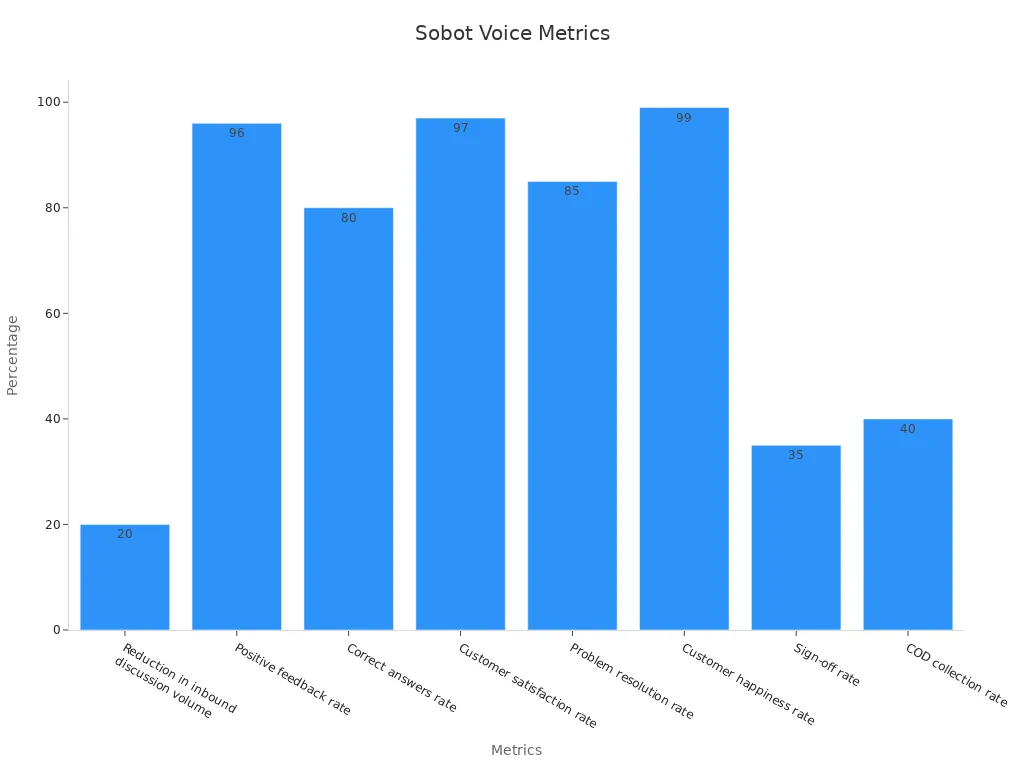
Seamless Integration for Maximum Efficiency
Sobot’s Voice/Call Center integrates effortlessly with your existing systems, including CRM platforms and customer service dashboards. This compatibility eliminates the need for complex setups, allowing you to deploy the solution quickly. Features like global number availability and smart call routing ensure that your team can handle customer inquiries efficiently, regardless of location or time zone.
By leveraging Sobot’s Voice/Call Center, you not only enhance your customer service metrics dashboard but also transform your support operations into a well-oiled machine. The result? Higher customer satisfaction, improved team productivity, and a competitive edge in the market.
Key Metrics to Track for Customer Support Excellence
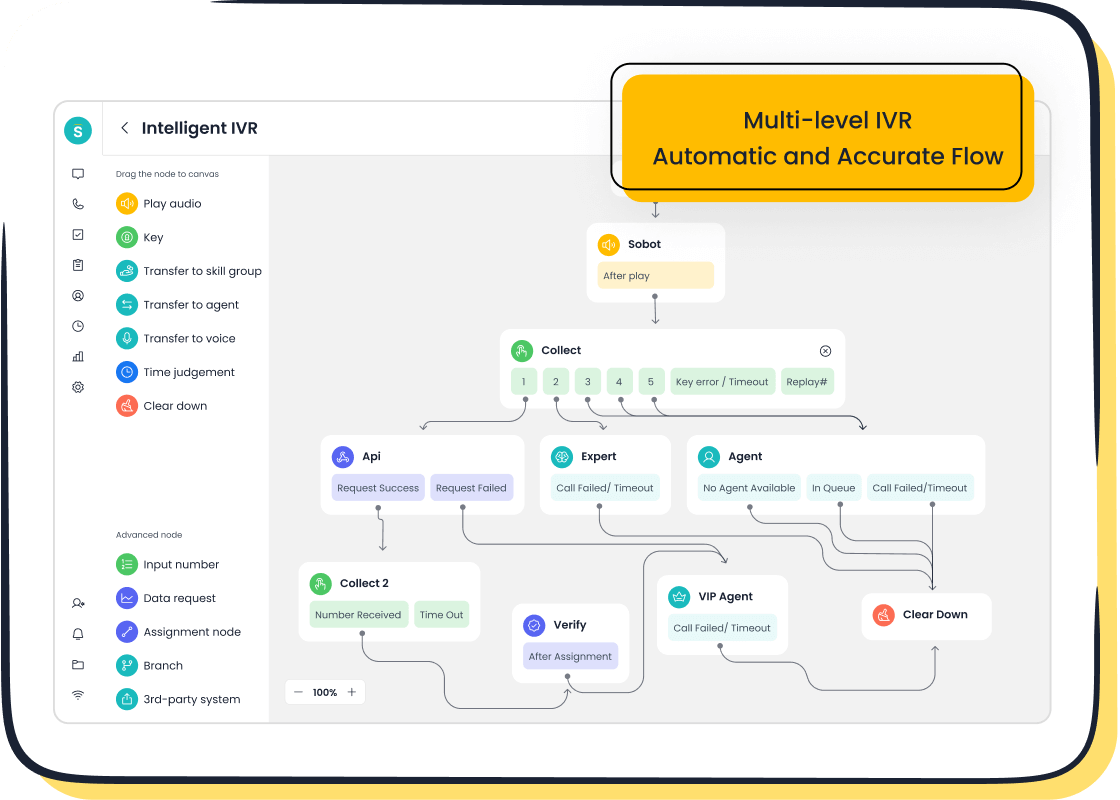
First Response Time (FRT) and its impact on customer experience
First Response Time (FRT) is one of the most critical metrics for customer support. It measures how quickly your team responds to a customer inquiry, setting the tone for the entire interaction. A fast response reassures customers that their concerns matter, while delays can lead to frustration and even brand abandonment.
Studies show that 53% of customers leave due to slow response times, and 79% are willing to switch brands for better service. By prioritizing FRT, you can improve customer satisfaction and loyalty significantly. For example, tracking FRT in real-time allows you to identify bottlenecks and allocate resources effectively.
Sobot’s Voice/Call Center enhances FRT by offering features like smart call routing and AI-powered Voicebots. These tools ensure inquiries are directed to the right agents instantly, reducing wait times and improving the customer experience. Faster responses not only boost satisfaction but also strengthen your brand reputation.
Customer Satisfaction Score (CSAT) for measuring service quality
Customer Satisfaction Score (CSAT) is a powerful metric for evaluating service quality. It gauges how satisfied customers are with a specific interaction, providing direct insights into your team’s performance. CSAT surveys are simple yet effective, asking customers to rate their experience on a scale, often expressed as a percentage.
Tracking CSAT helps you pinpoint areas of excellence and identify gaps needing improvement. For instance, if your average CSAT drops after implementing a new policy, you can quickly adjust to meet customer expectations. CSAT is particularly useful for department-wide changes, such as introducing new service channels or updating billing processes.
Sobot’s solutions, including its unified workspace, make tracking CSAT effortless. By consolidating customer data and communication channels, you gain a comprehensive view of satisfaction levels. This clarity allows you to implement targeted strategies that enhance service quality and drive customer loyalty.
Net Promoter Score (NPS) to assess customer loyalty
Net Promoter Score (NPS) is a key performance indicator that measures customer loyalty and predicts business growth. It asks a simple question: “How likely are you to recommend our service to others?” Responses are categorized into promoters, passives, and detractors, providing a clear picture of customer sentiment.
Research highlights NPS as a strong predictor of growth. For example, Reichheld’s study found that companies with high NPS scores outperform their competitors in revenue growth. Tracking NPS helps you identify loyal customers who can become brand advocates, as well as detractors who need attention to prevent churn.
Sobot’s Voice/Call Center supports NPS tracking by integrating real-time data dashboards. Features like call tracking and intelligent IVR ensure every interaction contributes to a positive customer experience. By leveraging NPS insights, you can refine your strategies and foster long-term loyalty.
Average Resolution Time (ART) for operational efficiency
Average Resolution Time (ART) is a critical metric that directly impacts your operational efficiency. It measures the time it takes to resolve a customer inquiry from start to finish. A shorter ART means faster resolutions, happier customers, and more efficient use of your team's resources. By focusing on reducing ART, you can streamline your operations and improve overall performance.
Efficient resolution times not only enhance customer satisfaction but also reduce operating costs. For example, a 1% improvement in First Contact Resolution (FCR)—a key factor influencing ART—can lead to a 1% reduction in operating costs and a 1.4-point increase in Net Promoter Score (NPS). Additionally, faster resolutions often result in a 20% increase in cross-selling acceptance rates, boosting your revenue potential.
| Metric | Impact |
|---|---|
| 1% improvement in FCR | 1% reduction in operating costs |
| 1% improvement in FCR | 1% improvement in customer satisfaction |
| 1% improvement in FCR | 2.5% improvement in employee satisfaction |
| Resolved calls | 20% increase in cross-selling acceptance |
| 1% improvement in FCR | 1.4 points increase in NPS |
Sobot’s Voice/Call Center helps you achieve lower ART by leveraging features like intelligent IVR and AI-powered Voicebots. These tools ensure that inquiries are routed to the right agents instantly, reducing delays. Real-time monitoring and call tracking provide actionable data, enabling you to identify bottlenecks and optimize workflows. With Sobot, you can transform ART from a challenge into a competitive advantage.
Tip: Regularly review your ART trends to identify areas for improvement. Even small reductions in resolution time can lead to significant gains in efficiency and customer satisfaction.
Ticket Volume trends for workload management
Understanding ticket volume trends is essential for effective workload management. By analyzing these trends, you can allocate resources more efficiently, prevent agent burnout, and maintain high service quality. Ticket volume often fluctuates due to various factors, and recognizing these patterns allows you to stay ahead of demand.
Here are some common trends that influence ticket volume:
- Seasonal Variations: Ticket volumes often spike during holidays or major shopping events. For example, retail businesses typically see a surge in inquiries during Black Friday or Christmas.
- Day-of-Week and Time-of-Day Patterns: Certain days or times experience higher ticket volumes. Mondays, for instance, often bring a backlog of weekend inquiries, while evenings may see increased activity in specific industries.
- Product Release Impact: New product launches or updates can lead to a significant increase in customer inquiries. Preparing for these spikes ensures smoother operations and better customer support.
Sobot’s unified workspace simplifies workload management by consolidating all customer interactions into a single platform. With real-time data analytics, you can monitor ticket volume trends and adjust staffing levels accordingly. For instance, during a product launch, Sobot’s bulk outbound task feature allows you to proactively address common questions, reducing the overall ticket load. This proactive approach not only improves efficiency but also enhances CSAT by ensuring timely responses.
Note: Use historical ticket volume data to predict future trends. This foresight helps you prepare for busy periods and maintain consistent service quality.
Implementing a Customer Service Metrics Dashboard Effectively
Selecting the right tools and software for your business
Choosing the right tools for your customer service metrics dashboard is crucial. The software you select should align with your business needs, budget, and scalability goals. Start by evaluating tools based on their features, pricing, and user reviews. For example, Scoro offers flexible pricing starting at $19.90 per user, while Databox provides AI-powered features at $319 per user. Both tools have strong customer ratings, making them reliable options for businesses of all sizes.
| Tool | Pricing (per user per month) | Average Customer Rating (G2) | Average Customer Rating (Capterra) |
|---|---|---|---|
| Scoro | $19.90 (Core) to Contact Sales (Enterprise) | N/A | N/A |
| Databox | $319 (Growth) for AI features | 4.4 | 4.6 |
When selecting software, prioritize dashboards that offer clear visuals, actionable insights, and reliable data accuracy. Tailor reports to your audience to ensure relevance, and use concise visuals to make data easy to understand. Sobot’s Voice/Call Center integrates seamlessly with dashboards, offering real-time monitoring and intelligent IVR features. These capabilities ensure your team has access to accurate, actionable insights for better decision-making.
Integrating Sobot’s Voice/Call Center with your dashboard
Integrating Sobot’s Voice/Call Center into your customer service metrics dashboard is a game-changer. This integration consolidates all customer interactions into a unified workspace, providing real-time data and actionable insights. Features like call tracking and AI-powered Voicebots enhance your ability to monitor key metrics such as Average Resolution Time and Customer Satisfaction.

For example, Sobot’s intelligent IVR routes calls to the right agents instantly, reducing wait times and improving customer satisfaction. The platform’s global number availability ensures seamless communication across time zones, while its 99.99% uptime guarantees reliability. By integrating Sobot’s solutions, you can streamline your operations, improve customer support, and make data-driven decisions that enhance service quality.
Training teams to leverage dashboard insights
Training your team to use dashboard insights effectively is essential for maximizing its value. Start by introducing tools like the Experience API (xAPI), which tracks learning activities and provides insights into training effectiveness. Analyze metrics such as course completion rates and employee performance to identify areas for improvement.
| Metric | Description |
|---|---|
| Number of employees engaging with training | Indicates participation levels in programs. |
| Course or program completion rate | Measures how many participants finish training. |
| Time-to-completion | Tracks the duration taken to complete modules. |
| Employee performance post-training | Assesses the impact of training on job roles. |
For instance, WIPRO used Whatfix DAP to enhance sales training by identifying gaps in how employees engaged with software. Similarly, you can use Sobot’s unified workspace to train agents on managing customer inquiries efficiently. By leveraging real-time data and actionable insights, your team can deliver exceptional customer support and drive better outcomes.
Tip: Regularly update training materials based on dashboard insights to ensure your team stays ahead of evolving customer needs.
Setting benchmarks and goals for continuous improvement
Setting benchmarks and goals is essential for ensuring your customer service team consistently improves and delivers exceptional results. Benchmarks act as a roadmap, guiding your team toward measurable success. Goals provide motivation and focus, helping you achieve higher levels of efficiency and customer satisfaction.
Start by identifying key metrics that align with your business objectives. Metrics like Customer Satisfaction Score (CSAT), Customer Lifetime Value (LTV), Monthly Recurring Revenue (MRR), and Customer Churn Rate are critical indicators of progress. These benchmarks allow you to track performance, identify gaps, and implement strategies for improvement.
David Antoni from Virtocommerce states, "Since using the customer service dashboard at Virtocommerce, there has been a significant improvement in our customer pulse detection which has its foundations rooted in structured and unstructured data recovered from support tickets."
To set effective benchmarks, use your customer service metrics dashboard to map required parameters with available data. Dashboards help you uncover business opportunities and track market trends worth investing in. For example, monitoring CSAT trends can reveal areas where your team excels and where adjustments are needed. Similarly, tracking churn rates can highlight customer retention challenges, enabling you to take proactive measures.
Sobot’s Voice/Call Center simplifies this process by providing real-time insights into metrics like Average Resolution Time and First Response Time. With features like intelligent IVR and AI-powered Voicebots, you can set achievable goals for faster resolutions and higher satisfaction rates. These tools ensure your benchmarks are actionable and aligned with your team’s capabilities.
Tip: Regularly review your benchmarks to ensure they remain relevant. Adjust goals based on evolving customer needs and market dynamics to maintain continuous improvement.
By setting clear benchmarks and actionable goals, you empower your team to deliver consistent, high-quality support. This approach not only enhances customer satisfaction but also drives long-term business growth.
The Future of Customer Service Metrics Dashboards
AI and automation in customer service dashboards
AI and automation are revolutionizing customer service dashboards, making them smarter and more efficient. These technologies automate repetitive tasks, allowing your team to focus on complex issues that require human expertise. For example, AI-powered tools can instantly categorize and route inquiries to the right agents, ensuring faster resolutions and higher customer satisfaction.
Automation also enables 24/7 support, giving your customers access to assistance anytime, anywhere. This round-the-clock availability not only enhances the customer experience but also reduces operational costs. Imagine a dashboard that uses AI to predict customer needs and provide personalized responses based on past interactions. This level of customization fosters deeper engagement and loyalty.
Sobot’s Voice/Call Center integrates AI-driven features like intelligent IVR and Voicebots, delivering tailored solutions while generating actionable data insights. These tools empower you to stay ahead in customer support by combining efficiency with personalization.
| Impact | Description |
|---|---|
| Faster Response Times | Reduces wait times, improving satisfaction. |
| Predictive Support | Anticipates needs, preventing issues before they arise. |
| Enhanced Employee Satisfaction | Frees agents from repetitive tasks, boosting morale. |
Predictive analytics for proactive customer support
Predictive analytics transforms your dashboard into a proactive tool. By analyzing historical data, it forecasts trends and identifies potential issues before they escalate. For instance, a forecast model can predict ticket volume spikes during seasonal events, helping you allocate resources effectively.
Outlier models detect anomalies, such as sudden increases in support calls, enabling you to address problems quickly. This proactive approach minimizes disruptions and enhances the overall customer experience. Businesses that adopt predictive analytics see up to an 80% increase in operational efficiency, as real-time insights drive smarter decisions.
Sobot’s dashboards leverage predictive analytics to optimize workflows and improve customer satisfaction. With features like real-time monitoring and intelligent routing, you can anticipate challenges and deliver seamless support experiences.
| Model Type | Description |
|---|---|
| Forecast Model | Predicts future outcomes, such as ticket volume during events. |
| Outliers Model | Identifies anomalies, like spikes in support calls or fraudulent activities. |
Customization and scalability for diverse business needs
Every business has unique requirements, and your dashboard should adapt to them. Customizable dashboards allow you to tailor metrics, visuals, and workflows to suit your specific goals. For example, a retail business might prioritize ticket volume trends, while a financial service provider may focus on first response times.
Scalability ensures your dashboard grows with your business. Whether you’re expanding into new markets or handling increased customer interactions, a scalable solution adapts seamlessly. Sobot’s dashboards integrate global data, enabling you to identify growth opportunities and maintain a competitive edge.
| Aspect | Evidence |
|---|---|
| Customization and Flexibility | Tailors dashboards to local markets while maintaining a cohesive strategy. |
| Global Reach | Integrates data from various locations, aiding in identifying growth opportunities. |
By choosing a dashboard that combines customization with scalability, you future-proof your customer support operations and ensure long-term success.
How Sobot’s solutions align with future trends
Sobot’s solutions are designed to keep you ahead of the curve in customer support. As technology evolves, trends like AI, automation, and predictive analytics are reshaping how businesses interact with customers. Sobot integrates these advancements seamlessly into its products, ensuring you stay competitive in a rapidly changing landscape.
AI and automation are at the heart of Sobot’s Voice/Call Center. Features like AI-powered Voicebots handle repetitive tasks, allowing your team to focus on complex customer needs. This not only improves efficiency but also enhances the customer experience. For example, businesses using Sobot’s Voicebots have reported a 20% reduction in inbound discussion volume, freeing up resources for more critical tasks.
Predictive analytics is another game-changer. Sobot’s dashboards analyze historical data to forecast trends, helping you anticipate customer needs before they arise. Imagine knowing when ticket volumes will spike or identifying potential issues early. This proactive approach ensures smoother operations and happier customers.
Scalability and customization are also key. Sobot’s solutions adapt to your business as it grows, whether you’re expanding into new markets or handling increased customer interactions. With global number availability and intelligent IVR, Sobot ensures your support operations remain efficient, no matter the scale.
By aligning with these future trends, Sobot empowers you to deliver exceptional customer support while staying ahead of the competition. Ready to future-proof your operations? Explore Sobot’s solutions today.
Tip: Embrace tools that combine AI, predictive analytics, and scalability to meet evolving customer expectations.
A customer service metrics dashboard is no longer a luxury—it’s a necessity for businesses aiming to excel in 2025. By tracking key metrics, you can enhance customer satisfaction, improve operational efficiency, and foster long-term growth. Dashboards provide actionable data that empowers you to make informed decisions, ensuring your customer support remains proactive and effective.
Consider the measurable benefits businesses have achieved through dashboards:
| Organization | Benefit Description | Improvement Percentage |
|---|---|---|
| Acme Financial Services | Increased client retention through dashboard insights | 31% |
| Global Manufacturing | Reduced complaint resolution times with real-time dashboards | 47% |
| MedCare | Improved appointment show rates via integrated dashboards | 28% |
Sobot’s solutions, like the Voice/Call Center, integrate seamlessly with dashboards to deliver these results. With features like real-time monitoring and AI-powered tools, Sobot ensures your customer service operations are efficient, scalable, and customer-focused. Equip your business with the tools to exceed expectations and thrive in a competitive market.
Tip: Start leveraging dashboards today to transform your customer support into a growth engine for your business.
FAQ
What is a customer service metrics dashboard, and why do you need one?
A customer service metrics dashboard is a tool that tracks and visualizes key performance indicators like response times and satisfaction scores. It helps you improve customer support by identifying trends, optimizing workflows, and enhancing service quality. Tools like Sobot’s Voice/Call Center make integration seamless and effective.
How does real-time data improve customer support?
Real-time data allows you to monitor metrics like ticket volume and resolution times instantly. This helps you address issues proactively, ensuring smoother operations and happier customers. Sobot’s dashboards provide live insights, enabling faster decisions and better outcomes.
Can Sobot’s solutions integrate with existing systems?
Yes, Sobot’s Voice/Call Center integrates effortlessly with your current CRM and customer service tools. This ensures a unified workspace for managing customer interactions, improving efficiency, and delivering exceptional support experiences.
What metrics should you prioritize on your dashboard?
Focus on metrics like First Response Time, Customer Satisfaction Score, and Average Resolution Time. These indicators reveal how well your team meets customer expectations. Sobot’s dashboards simplify tracking these metrics, helping you achieve measurable improvements.
How do dashboards enhance team productivity?
Dashboards streamline workflows by consolidating data and highlighting actionable insights. This reduces time spent on repetitive tasks and improves accountability. Sobot’s unified workspace empowers your team to manage inquiries efficiently, boosting productivity and customer satisfaction.
See Also
Discovering Leading Cloud Contact Centers for 2025
Best Reviews of Cloud Contact Center Services in 2024
Enhancing Call Center Efficiency Through Effective Monitoring
